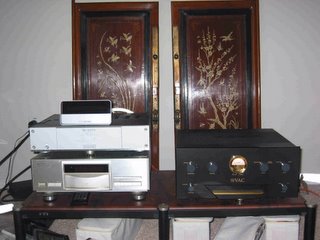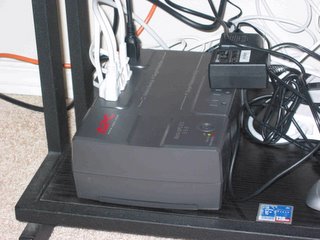I had hoped to write a long detailed review of several things: the SB3 unmodified vs. a power supply upgrade, and a Bolder-modified SB3 vs. Stock, and the modified vs. my transport, etc.
These days, I am lucky to get uninterrupted listening time twice a week. I had a few hours this weekend , so this will be a quick overview. I’ve written a number of reviews for gear I’ve owned, but this was probably the toughest. Usually, there is a clear “winner” if I am comparing products, but the Squeezebox has me alternatively smiling, tapping my toe, gritting my teeth, or puzzling over whether the sound I hear is better or the same.
My CD transport is a rare Pioneer Elite PD-S95, a showpiece 40 lb stable platter transport that Pioneer made in tiny quantities, and last sold for $3k, and with a brand new laser and a Herbie Grundgebuster CD mat). Music burned via iTunes (WAV with error correction on). Stock SB3 (wifi) and Bolder modified SB3 (digital only mod, with Deluxe PS).
Stock SB3 vs. Transport/Tri-Vista. No contest. The transport smoked a stock SB3. Bass through the SB3 was thinner, soundstage was flatter, highs lacked air and extension, voices and instruments did not have the definition and weight of the transport/DAC combo. I will say that a stock SB3 does acquit itself rather nicely for $300; however, high end CD manufacturers should not lose sleep fearing a stock SB3 will take sales away. But they shouldn’t rest easy…
Stock SB3 into Tri-Vista vs. Transport/Tri-Vista Much closer, but the Transport/Tri-Vista held the lead. Biggest areas of difference were still bass definition, soundstage, and “airiness”. The Transport/Tri-Vista still had that “presence” and palpability unique to high end gear, while the SB3/Tri-Vista was a cut below. I would compare the stock SB3/Tri-Vista combo to my old transport: a Technics DVD A10, or a cheapie Toshiba. Good, but you only find out what you are missing when you add a really good dedicated transport and digital cable.
Stock SB3 with upgraded Bolder Deluxe PS/Tri-Vista vs. Transport/Tri-Vista It is getting much closer now. Switching back and forth, they are both very musical. But the transport is still more believable, more realistic in rendering differences between vocals and instruments. By analogy, my VAC Avatar has two modes; triode and ultralinear. Triode is sweet and the presence is quite amazing (SET-like); Ultralinear rocks more but is less involving. Both are musical, but my preference is triode mode and its “reach out and touch the musicians” appeal. This is the same as I heard with the SB3 vs. transport. The SB3 was like the ultralinear mode, the transport like the triode mode.
Bolder Digital Upgrade/Deluxe PS/Tri-Vista vs. Transport/Tri-Vista WOW!!!! What happened? The roles are nearly reversed. Now, vocals through the SB3 are stunning and pure. Detail abounds; you can hear the layers of instruments in good classical and jazz recordings; steel pedal guitars resonate wonderfully with that instantly recognizable tone. Bass detail is far more distinct with the SB3. The transport, by comparison, now sounds “grundgier”, with less detail. However, the transport seems to imbue the vocals and instruments with a bit more “weight” and body. The SB3 bests the transport in most areas except for this “body” thing. And while the SB3’s bass detail is much better, the transport actually seems to add more bass slam. It’s as if the SB3 is tad lightweight. Both are really really musical, and I have to hold my leg still when listening critically. But I think the SB3 gains the upper hand here.
I brought my wife in for a listen (what a great sport, listening to 10 repeat loops of Three Dog Night, Al Green, Norah Jones, and Martin Sexton). She preferred the SB3 too, but also noticed the SB3 seemed just a tiny tad lighter sounding than the transport. I tried a few things to see if something else was contributing to the lack of weight. First, I switched the Asylum cable (DIY AC cable) I was using with the Bolder PS to a Cardas Golden reference cable. Much better. Now some of the weight seems to return.
I’d like to get another Foundation Research LC-1 power cable/conditioner to add to the mix, this solved similar problems before and outperformed the Cardas AC cable. But an LC-1 costs $800 new, and I’ve already sunk enough into the SB3 and mods and Mac Mini system.
The convenience of the SB3/Mac Mini combo would probably be enough by itself for me to switch completely over. Now, the sound quality is pretty much better in almost all areas over my CD transport. It’s no contest. The only thing nagging at me to keep my transport around is the general reliability of computer systems vs. audio gear. I’ve had a few hiccups with the SB3 connecting to the Mac Mini, all caused by standard networking or computer performance issues (that was the teeth gritting I referred to above). Also, if the labels have their way, future CD’s will be copy-protected and may not actually be able to be ripped to computer.




